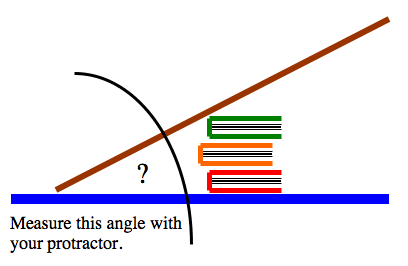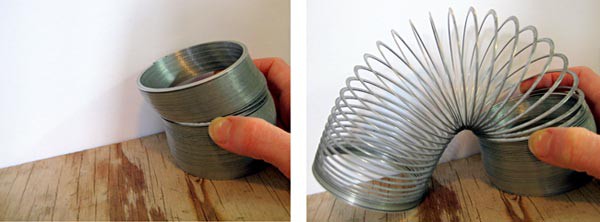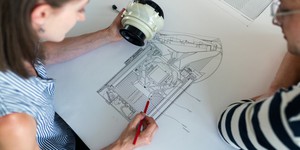Abstract
Want to do a project with a toy your parents, or even grandparents, might have played with? Slinkies are fun toys that also make great physics and engineering projects. In this science project you will investigate how changing the angle of an inclined plane affects how the Slinky walks down it. What angle will enable the Slinky to go for the best walk?Summary
Teisha Rowland, Ph.D., Science Buddies
Sources
- Byrne, E. (n.d.). Slinky Walking Speed vs. Angle. Slinky Home Page. Retrieved December 13, 2012.
- Slinky® is a registered trademark of Poof-Slinky, Inc.

Objective
Investigate how the angle of an inclined plane affects how a Slinky can walk down the inclined plane.Introduction
The Slinky is a classic American toy, with roots in Pennsylvania. The inventor of the Slinky was a retired Navy engineer named Richard James. He initially thought the bouncy springs, or coils, would be useful for supporting sensitive instruments onboard rocking ships at sea. But when the Navy had no interest in his springs, his wife Betty had a better idea. She thought up a catchy name and Slinky the toy, shown in Figure 1, was born in 1945.

Figure 1. The classic Slinky—fun for all ages!
The Slinky has a unique ability to "walk" down steps or a sloping surface. How does it do this? The Slinky slowly flips end over end. If you watch closely, you will see it stretches to reach the next step down, reforms itself, then stretches again to reach the next step, and so on. The Slinky can do this because of gravity (a force that pulls things down, towards the ground) and the Slinky's own momentum. If something is in motion, or is moving, it is momentum that makes that thing want to keep moving. This process is how a Slinky can walk down a sloping surface like an inclined plane, which is a type of sloping surface that is also a simple machine. Can the Slinky walk down the inclined plane when it is set to any angle, or does the Slinky walk better at certain angles? In this mechanical engineering science project, you will make a simple inclined plane to test how the Slinky walks down the inclined plane when it is set to different angles.
Terms and Concepts
- Coils
- Gravity
- Momentum
- Inclined plane
- Angle
- Protractor
Questions
- How does a Slinky "walk" down steps or a sloping surface?
- What is an inclined plane? How could one be built?
- What angle do you think will be best for the Slinky to slink down the inclined plane?
Bibliography
Read about how the Slinky was invented from this website for young inventors at the Massachusetts Institute of Technology:- Massachusetts Institute of Technology (MIT). (n.d.). Inventor of the Week Archive: The Slinky. MIT School of Engineering, Lemelson-MIT Program. Retrieved December 10, 2012.
- Newton's Apple. (n.d.). Slinky Physics. Michigan Reach Out!. Retrieved December 10, 2012.
- Gonzalez, R. T. (2012, June 25). High-speed video reveals the bizarre physics of Slinkys. io9. Retrieved December 10, 2012.
- National Center for Education Statistics. (n.d.). Create a Graph. Retrieved June 2, 2009.
- Byrne, E. (n.d.). Slinky Walking Speed vs. Angle. Slinky Home Page. Retrieved December 13, 2012.
Materials and Equipment
- A large piece of plywood. Try to find one that is at least two feet long by one foot wide.
- Stack of books
- Protractor
- Stopwatch
- Metal Slinky (full size, not a Slinky, Jr.); available from Amazon
- A helper
- Lab notebook
Experimental Procedure
- To make your adjustable inclined plane, rest one of the narrow ends of your piece of plywood on a stack of books. (Rest the opposite end of the plywood on the floor.) To adjust your angle, simply add or remove books to the stack.
- Adding books will increase the angle and removing books will decrease the angle.
- Measure the angle formed where the base of the plane meets the floor with a protractor, as shown in Figure 2. Begin by setting the angle to 15 degrees.

Figure 2. Use your protractor to measure the angle formed where the base of the plane meets the floor. This is the angle you will be measuring and using in this science project.
- In your lab notebook, create a data table like Table 1. You will be recording your results in this data table.
- You will be testing three different angles on the inclined plane (15°, 20°, and 25°). For each angle, you will do five trials with the Slinky, so make space in your data table for this.
- Doing a test multiple times helps you ensure that your results are accurate and reproducible.
| Angle | Trial Number | Number of Flips | Time (seconds) | Flips per Second |
| 15° | 1 | |||
| 2 | ||||
| etc. | ||||
| Average | ||||
| 20° | 1 | |||
| 2 | ||||
| etc. | ||||
| Average | ||||
| 25° | 1 | |||
| 2 | ||||
| etc. | ||||
| Average |
Table 1. In your lab notebook, create a data table like this one. You will be recording your results in the data table in your lab notebook. You will be doing five trials for each angle, so make enough space in your data table for this.
- Have your helper get the stopwatch ready.
- At the top of the inclined plane, hold the Slinky so that it is bent over, making an upside-down U. Let the lower part of the Slinky just barely touch the plane, as shown in Figure 3. (This may mean that you are holding around half to two-thirds of the Slinky's coils on the upper part of the plane.)
- This will help give the Slinky some momentum to get going down the plane!
 Image Credit: Teisha Rowland, Science Buddies / Science Buddies
Image Credit: Teisha Rowland, Science Buddies / Science Buddies
Figure 3. Hold the Slinky at the top of the inclined plane, as shown on the left here, and then bend the Slinky over so that the bent part of the Slinky just barely touches the lower part of the plane, as shown on the right here. This may mean that you are holding around half to two-thirds of the Slinky's coils in your hand.
- Release the Slinky and have your helper start the stopwatch. Count the number of flips the Slinky makes down the inclined plane. Have your helper stop the stopwatch when the Slinky reaches the end of the plane.
- Tip: Make sure the Slinky does not tumble down the plane, but actually flips end over end. Do not count any of the trials in which the Slinky tumbled.
- In the data table in your lab notebook, write down the number of flips the Slinky made and the time it took to reach the bottom of the plane.
- This is trial #1 at 15°.
- Calculate the speed of the Slinky in flips per second. To do this calculation, divide the number of flips you counted by the number of seconds you measured. Write your answer in the data table in your lab notebook.
- Repeat steps 4-8 four more times so that you have done five trials total at a 15° inclined plane.
- Be sure to release the Slinky from the same place at the top of the inclined plane each time.
- In steps and 7 and 8, record your data as a different trial each time.
- Change the angle of the inclined plane so that it is now at 20°. Measure the angle with a protractor as you did in step 2 to confirm that it is at 20°.
- Repeat steps 4-9, but this time with the inclined plane at a 20° angle.
- Change the angle of the inclined plane so that it is now at 25°. Measure the angle with a protractor as you did in step 2 to confirm that it is at 25°.
- Repeat steps 4-9, but this time with the inclined plane at a 25° angle.
- Calculate the average number of flips, time (in seconds), and flips per second for each of the three angles you tested. In the data table in your lab notebook, write your answers in the row labeled "Average" for each angle.
- To do these calculations, add up the numbers in one of the columns for all five trials at a certain angle. Divide this number by five (since you did five trials) to get the average.
- For example, if the times from the five trials when the inclined plane was at 20° were 2.0, 1.9, 1.8, 1.9, and 1.7 seconds, the total would be 9.3 seconds and the average would be 1.9 seconds (9.3 seconds divided by five).
- Make three different bar graphs of your results. Make one graph of the average number of flips counted at the different angles, one graph of the average time (in seconds) measured at the different angles, and one graph of the average flips per second at the different angles.
- For each of the three graphs, put the angle of the inclined plane on the x-axis (the horizontal axis going across the bottom). For one graph put the average number of flips counted on the y-axis (the vertical axis going up and down), for another graph put the average time (in seconds) on the y-axis, and for the third graph put the average flips per second on the y-axis.
- You can make a graph by hand or use a website like Create a Graph to make a graph on the computer and print it.
- How do your results at different angles compare? Did the Slinky go faster or slower down the inclined plane as you increased its angle? Did the Slinky make less flips down the plane as the angle increased? Did the Slink's flips per second change as the angle changed? Overall, at which angle do you think the Slinky went for the best walk down the plane? Why do you think all of this is?
Ask an Expert
Global Connections
The United Nations Sustainable Development Goals (UNSDGs) are a blueprint to achieve a better and more sustainable future for all.
Variations
- In this science project you investigated how a Slinky walks down an inclined plane at 15°, 20°, or 25° angles, but you can change your inclined plane to create a much smaller or greater slope than these and investigate how well the Slinky walks at the more extreme angles. What are the smallest and largest angles that the inclined plane can be for a Slinky to still be able to "walk" down it?
- A small Slinky, like a Slinky, Jr., might walk down an inclined plane differently than a larger Slinky. Similarly, a plastic Slinky might travel differently than a metal one of the same size. Pick the angle that worked best in this science project and separately try two different types of Slinkies, either different sizes (but made of the same materials) or made out of different materials (but the same size). How do the different Slinkies walk down the plane? Does one make more flips or travel faster than the other at the same angle? Why do you think this is?
- There are many ways to use a Slinky for a science experiment:
- Put the two ends on the floor and jump to find out how you can use the Slinky as a wave detector.
- You can use the Slinky to study compression waves by wiggling it back and forth.
- If you bang on the Slinky you can generate sound. Can you make different pitches?
- Slinkies have also been used as giant antennae.
- What else can you think of?
- Advanced students can use linear regression to further analyze the data. Can you define an equation that expresses the relationship between the angle of incidence and the walking speed for this system? What is the error in your experiment? Are your results significant?
Careers
If you like this project, you might enjoy exploring these related careers:









